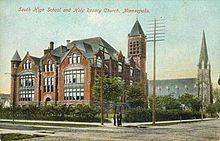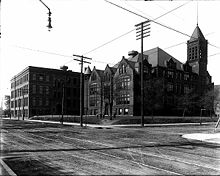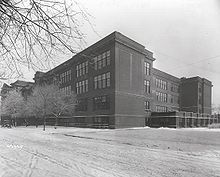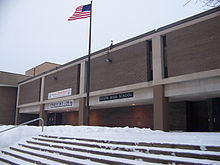- South High School (Minneapolis)
-
For schools of a similar name, see South High School.
South Senior High School 
Location 3131 19th Avenue South
Minneapolis, Minnesota, United StatesCoordinates 44°56′44″N 93°14′37″W / 44.9456°N 93.2435°WCoordinates: 44°56′44″N 93°14′37″W / 44.9456°N 93.2435°W Information Type Public secondary Established 1885 School district Minneapolis Public Schools Principal Cecilia Saddler[1] Faculty 115[2] Grades 9–12[1] Number of students 1,963[1] Color(s) Orange and Black Mascot Gallant Tigers Newspaper The Southerner Website http://south.mpls.k12.mn.us South Senior High School is the largest public school (state funded) in Minneapolis, Minnesota, located in Corcoran neighborhood. Its student population is 1963, with a staff of 115 as of the 2009–10 school year. The school's principal is Cecilia Saddler, who is assisted by three assistant principals and administration from each Small Learning Community.
Contents
History
Origins
South High School was formed in 1885 inside of four rooms in the attic of the old Adams School at Franklin Avenue and Sixteenth Avenue.[citation needed] It was in this setting that South High School began many traditions that continue to this day.[citation needed] The small student body of this school within a school began publishing the South High Observer, the direct predecessor to today's school paper: The Southerner. South High Theater presented its first play—Cox and Box—in 1892. Several years after its humble start South had its first graduation, totaling twenty-seven students. Within several years, South had outgrown the Adams School and the Minneapolis School Board began a search to find a new, larger location for the school.
They found a plot of land, purchased from a man named Frank Murphy, that had once housed an orchard and a cornfield. It was on this newly acquired land that the foundation for the new South High was laid. The building was completed on or around New Years Day, 1892, and in 1893, the 250 students of South High School and the 208 students of the adjoining middle school took the triumphant march to their new building, at 2445 18th (or Cedar) Avenue South.[citation needed]
The new building was a masterpiece.[verification needed] Built out of red brick and sandstone in a castle-like structure, in typical 1890s architectural fashion, it featured multiple turrets, twelve-foot ceilings, stained-glass bay windows and a six-story bell tower.[citation needed] After the last part of the building, the bell tower, was erected, it was decided by the School Board not to purchase a bell for it.[citation needed] The reasons for this are unclear, but it is thought that the large bell used to mark the beginning and ending of classes was ditched in favor of an electric bell system run by a motor. The bell tower would remain until the rest of the building around it was destroyed.[citation needed]
The student body kept growing at a fast pace, it had grown to between 750 and 800 students by 1909. The once spacious quarters of the school had become small, and the auditorium was sacrificed for more classrooms by dividing it up into four quarters using green curtains.[citation needed] Students had trouble concentrating with this setup, and the Minneapolis School Board decided changes needed to be made.
That first significant change came in September 1910 when the new manual and training wings were opened.[citation needed] This new part of the school allowed students to be trained into business and other commercial professions. The highest reported number of students taking classes in this part of the school at any time was 800 students, using 149 typewriters along with other equipment.[citation needed] In January 1911, a new auditorium was opened up to the graduating class, with an initial seating capacity of 1,913. In contrast, South High's current auditorium has a listed seating capacity of 715. The new auditorium space, along with the manual and training wings, consisted of a new style of architecture. No clear pictures of these additions are available, and the only description offered for the style was "medieval."
The final extension to the school came in 1916. Most of the original structure was demolished to make room for a new large building. The new structure, still connected to the old structure and the manual and training wings, followed the architectural style of its time, with a square look and evenly cut windows, at least one to a room.[citation needed] Several schools in the area from this period and architectural style remain.[citation needed]
The "Golden Age"
With this last part of the central school building added, South High School became one of the architectural wonders of the city of Minneapolis, featuring three different sections with different architectural styles, linked together in an offbeat harmony.[citation needed]
This paragraph from the January 1927 Parent-Teacher Broadcaster summarizes it and the parts inside it the best:
“ "[T]he building itself...is so constructed that its architecture may be easily spoken of as ancient, medieval, and modern; or, in other words, there is the old main building with its fantastic design, than the manual training wing, medieval in structure, and lastly, the new building of modern architecture. The whole, colossal in size and modern to the nth degree, is set in extensive grounds, which may later be used for additional building sites. We discover a large manual training department where every line of work properly falling under that head is adequately housed and furnished with wonderfully complete equipment. We are pleased that all classrooms are wonderfully large, light, and airy." ” After the First World War, work began on an athletic field, which was built across Cedar Avenue from the building. No more details on its initial construction can be found.[citation needed]
A number of changes to the school were requested by the parents and teachers of South High in 1924.[citation needed] These included a new chorus room, or band room, to seat 400 students, fireproofing and alteration of the auditorium, a new gymnasium, and improvement of the athletic field.[citation needed]In the summer of 1926 the auditorium was remodeled and fireproofed, a process that cut the seating capacity from 1,913 to 1,655.[citation needed] At the same time, sets of stairs were added leading out to Cedar Avenue to relieve ever-growing congestion at entryways. The band room was expanded, facilitating its rampant growth and eventually spurring other schools to develop programs of their own. The athletic field was finished, complete with a concrete fence, comfortable seating, and a large gateway dedicated to the South students who died in the First World War. In addition, the old gymnasium was replaced by two new ones, separated by a partition—one side for boys, the other for girls.[citation needed]
The height of what is known as South's Golden Age, which lasted from 1916 to about 1940, came, ironically, during the height of the Great Depression.[citation needed] In 1933, South High School had 2,820 enrolled students, and, despite the misery of the outside world, the school continued to grow and prosper and show students the possibility of a better life away from the Depression.[citation needed]
The end of the old South High building came in the 1940s, as the oldest part of South started to show distinct signs of age. The stonework began to crumble. The wooden floors that comprised all of the old section of the school were warped and wavy. Even the furnishings and old art that lined the walls was still there. Few classes were held in the old section of the school anymore and when it rained, the roof leaked, sending water streaming down its labyrinthine corridors.[citation needed]
In the summer of 1950, wrecking hammers went to work on the front of the old school, an action met with vigorous protest, a large part of it coming from alumni. It would take until 1953 to destroy the old third of the building, leaving the other two parts untouched.[citation needed]
They did not remain untouched by controversy for very long, however. In 1961 South High principal Carl Lundin sent a petition to the Minneapolis School Board for a new South High School. The Citizens Group, people interested in saving historic buildings, met this with protest. Their protest was met with counter-protest, setting off a seven-year period of constant protest. Several different sites were considered for building the new South High, and one was only decided on four and a half years after the original proposal. The plans met further trouble after that when a building plan upon which could not be agreed. The proposal that brought the most anguish after it was rejected was the City Council's refusal to close 31st street to accommodate the new athletic field. It brought the most news attention of any problem and yet it seems like a silly issue today – the athletic field is simply across 31st street from the building. Contracts for the New South were finally awarded in early October 1968 and a groundbreaking ceremony was held on October 11, 1968, using five shovels engraved with letters spelling "SOUTH". The class of 1969 became the last class to graduate in the antiquated South High building. Partway through the next year, classes switched to the new school and the Old South was destroyed.
The New South
The open house for the new South High School was held on October 11, 1970, exactly two years after the groundbreaking ceremony.
At this time in history, the nation was experiencing great turmoil within its boundaries due to the prolonged Vietnam War and the government's cover-up of vital information about the true progress of the war. Construction for the New South began in 1968, the year when public opinion of the war took a big turn for the worst. Just a few months before the gala open house for the new building the Kent State shootings occurred – four students were killed by National Guardsmen during a protest of the war and of government policy, sparking a new round of student protest across the nation.
From the outside, South looks like a brick fortress. The new building was possibly made to counter the student unrest of the times. Windows are absent from the original building. Windows are prone to shatter easily unless expensive shatterproof glass is used. Structures of this time period tend to lack windows, which could be quickly destroyed by any violent protest around them, a common occurrence, making them at best expensive to replace and at worst a public safety hazard. The original floor plans also changed with more additions, such as the third floor, added in the late nineties with the seeming innovation of windows.
However, students at South High were given an equally plausible explanation for the somewhat prison-like structure. The architect for the New South Project was from Texas, and his interpretation for energy efficiency over the long winters caused him to edit any extensive use of windows. Additionally, when the building first opened, it was an "Open School," with no individual classrooms on the second floor. The small windows that were used in the design provided light across the open area. Only when the school was converted to typical classroom divisions did the lack of natural light become an issue.
The original floor plan was open, in keeping with the educational philosophies of the time. Ideally, such a configuration would allow for shared learning among students in different classes. More pragmatically, the open floor plan produced distractions and additional interior walls were added later to separate different classrooms from one another. The construction of classrooms after the fact created a "rabbit maze" of identical hallways, and in some instances classrooms that are only accessible via other classrooms.
Current Architecture
The South High School building has three floors which surround an auditorium, commons area, and balcony. An ongoing joke for new freshman was the existence of a fourth floor that does not overlook the commons. Said fourth level has a fantastic view of downtown in some of the language classrooms, or at times is alleged to have a swimming pool. The first floor contains the main office, auditorium, general instruction classrooms, biology classrooms and technology/shop classrooms. The second floor contains many mathematics, social studies and English language arts classrooms, as well as the Media Center. It now also has a small studio theatre called the "Skybox", which will be used for one-act plays written and directed by South students. It was paid for, for the most part, by alumnus Josh Hartnett, and Friends of South High Theater raised the other money. The third floor, constructed during the 1996–97 school year, houses advanced science classrooms, language classrooms, storage, Triple E classrooms, and All Nations classrooms. In the summer of 2001, the auto shop was turned into a band room to meet the ever-growing need of that department, and the ventilation system was remade to allow for more efficient air conditioning. Each student is issued an identification card, which is checked upon entry through all entrances, to ensure the safety of the students and staff.
In Spring 2007, a project to renovate all of the public high school auditoriums in Minneapolis moved on to the South auditorium. The renovations, which had finished by the beginning of the 2007-08 school year include all new lighting and sound equipment, an extensive box for lighting and sound control, two sets of double doors at the main auditorium entrance, and a wheelchair accessible balcony. Theatrical performances on the stage began in Spring 2007. Due to space restrictions, there is no fly system.
Small Learning Communities
The school has three different Small Learning Communities (SLCs). They are Liberal Arts, Open, and All Nations American Indian. During the summer of 2006, the Triple E (Environment, Empowerment, Essentials) program was eliminated, and students belonging to those SLCs were placed into the Open and Liberal Arts communities. It is at this time unknown what will happen to the assistant principles and counselors that were previously assigned to the Triple E community. There are, in addition, several programs for special education students and teenage parents.
Student body and academics
There was so much interest in the school during the 1990s that local newspapers printed articles with parents stating that if their child's application to the magnet program at South was not accepted, they would send their child to private school. South has extensive offerings in general education, special education, athletics, and world languages (French, Spanish, German, Latin, Chinese, Ojibwe, and for many years also Russian). The school is renowned for its cultural diversity, with students from White, African-American, Asian (particularly Hmong), Northeast African (particularly Somali and Oromo), American Indian, and Hispanic communities. There is an increasing number of Eastern European students.
While many academic programs at South are widely respected, the South student body also experiences a significant achievement gap. Students from wealthier and more educated families tend to be enrolled in Advanced Placement and College in the Schools classes, and attend college after high school much more frequently than students from other socio-economic backgrounds. This trend is also discernible by ethnic background. In fact, a significant percentage of South students drop out of school completely before graduation. These trends exemplify the sociological concept of social reproduction, whereby barriers to social mobility prevent the poor from leaving poverty. The state of Minnesota, to comply with the federal No Child Left Behind legislation, has given SHS two stars out of five in both reading and mathematics. This means that South failed to meet federal accountability standards in both categories in the preceding academic year. The school received nationwide press in 2005 after it introduced an on-line physical education (P.E.) class. The program allows students to select a physical activity of their preference and then engage in that activity three times a week in order to meet the P.E. requirements of the school. This is a district wide program.
Events and organizations
There are many annual events on the school year schedule, such as the open house, parent-teacher conference days, homecoming, athletic events, dances, and other social events. Many students arrive early or leave late to participate in extracurricular ("co-curricular" is the administration's preferred term) activities including ethnic student associations, language clubs, competitive academic groups, mock trial, Academic Decathlon, Quiz Bowl, debate, and political groups. SHS has a very active theatre company. Some of their plays are student directed and many parts of the production encourage student involvement (for instance, the sets are designed and built by students.) South High School is also a powerhouse when it comes to national academic competitions and is a tradition for South Students. In 1998 South's Mock Trial team was 2nd in State, in 1999 they were State Champions and ranked nationally, in 2005 students took fourth place in the nation in the Mock Trial competition. and in the 2006 national competition, South took twelfth place. The South Mock Trial team stopped competing before the 2007 season. In 2005 South was ranked first in National History Day.
Athletics
South's girls basketball team rose to prominence in the last several years when Ahmil Jihad assumed the head coach position. The same year, Tayler Hill joined the team as an 8th grader. Hill won the state scoring title her sophomore and senior years and led South to a 139-14 record in her five-year career. After two consecutive Minnesota State High School League Class AAAA state championship losses to St. Paul Central, Minneapolis South got what they longed for by beating Centennial High School 68-61 in the 2009 class AAAA state final. Tayler Hill led all scorers, tying the all-time tournament record for most points in a single game with 47. Hill broke several Minnesota high school records in her senior season, including most career points with 3,894, most points in a single season with 1,053, and most free throw makes and attempts in a single season (270/350).
Notable alumni
- Michael Bland - Drummer with Prince
- Rachael Leigh Cook - Actor, known for She's All That and This Is Your Brain on Drugs
- Joe Gantenbein - Infielder for the Philadelphia Athletics
- Genevieve Gorder - TV host of Dear Genevieve
- Josh Hartnett - Actor, known for Pearl Harbor and 30 Days of Night
- Hassan Mead - Cross country runner
- Carl Lumbly - Actor, known for Alias and Cagney and Lacey
- Carl C. Rasmussen - Los Angeles City Councilmember
- Cathy Wurzer - TV host of Almanac
References
- ^ a b c "SOUTH SENIOR HIGH 2010" (PDF). Minnesota Department of Education. p. 1. http://education.state.mn.us/ReportCard/2010/RCF000103362.pdf. Retrieved 2 December 2010.
- ^ "SOUTH SENIOR HIGH Student Teacher Ratios". Minnesota Department of Education. http://education.state.mn.us/ReportCard2005/StudentTeacherRatio.do?SCHOOL_NUM=362&DISTRICT_NUM=0001&DISTRICT_TYPE=03. Retrieved 2 December 2010.
- Condon, Patrick. "Online phys ed takes hold in Minneapolis", USA Today. October 21, 2005. Retrieved October 29, 2008.
Edison High School · North Community High School · Patrick Henry High School · Roosevelt High School · South High School · Southwest High School · Washburn High School
Categories:- Educational institutions established in 1885
- High schools in Minneapolis, Minnesota
- Minneapolis Public Schools
Wikimedia Foundation. 2010.




